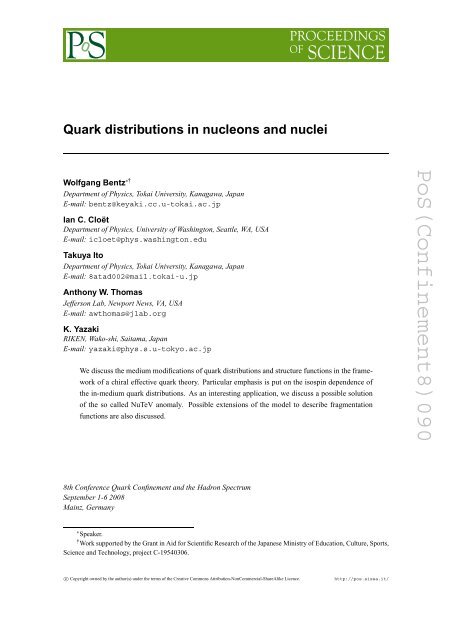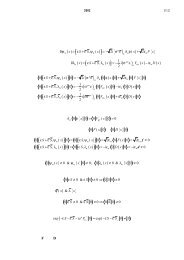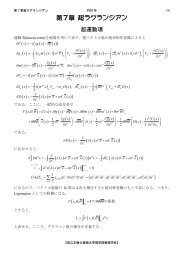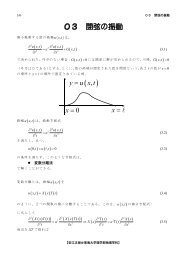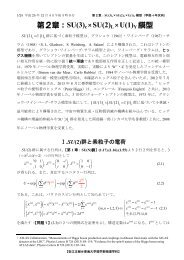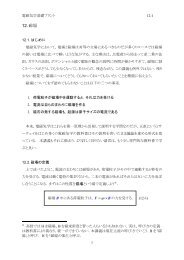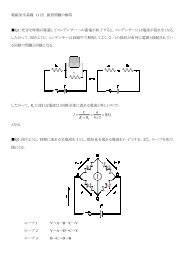Quark distributions in nucleons and nuclei.
Quark distributions in nucleons and nuclei.
Quark distributions in nucleons and nuclei.
Create successful ePaper yourself
Turn your PDF publications into a flip-book with our unique Google optimized e-Paper software.
<strong>Quark</strong> <strong>distributions</strong> <strong>in</strong> <strong>nucleons</strong> <strong>and</strong> <strong>nuclei</strong><br />
Wolfgang Bentz ∗†<br />
Department of Physics, Tokai University, Kanagawa, Japan<br />
E-mail: bentz@keyaki.cc.u-tokai.ac.jp<br />
Ian C. Cloët<br />
Department of Physics, University of Wash<strong>in</strong>gton, Seattle, WA, USA<br />
E-mail: icloet@phys.wash<strong>in</strong>gton.edu<br />
Takuya Ito<br />
Department of Physics, Tokai University, Kanagawa, Japan<br />
E-mail: 8atad002@mail.tokai-u.jp<br />
Anthony W. Thomas<br />
Jefferson Lab, Newport News, VA, USA<br />
E-mail: awthomas@jlab.org<br />
K. Yazaki<br />
RIKEN, Wako-shi, Saitama, Japan<br />
E-mail: yazaki@phys.s.u-tokyo.ac.jp<br />
We discuss the medium modifications of quark <strong>distributions</strong> <strong>and</strong> structure functions <strong>in</strong> the framework<br />
of a chiral effective quark theory. Particular emphasis is put on the isosp<strong>in</strong> dependence of<br />
the <strong>in</strong>-medium quark <strong>distributions</strong>. As an <strong>in</strong>terest<strong>in</strong>g application, we discuss a possible solution<br />
of the so called NuTeV anomaly. Possible extensions of the model to describe fragmentation<br />
functions are also discussed.<br />
PoS(Conf<strong>in</strong>ement8)090<br />
8th Conference <strong>Quark</strong> Conf<strong>in</strong>ement <strong>and</strong> the Hadron Spectrum<br />
September 1-6 2008<br />
Ma<strong>in</strong>z, Germany<br />
∗ Speaker.<br />
† Work supported by the Grant <strong>in</strong> Aid for Scientific Research of the Japanese M<strong>in</strong>istry of Education, Culture, Sports,<br />
Science <strong>and</strong> Technology, project C-19540306.<br />
c○ Copyright owned by the author(s) under the terms of the Creative Commons Attribution-NonCommercial-ShareAlike Licence.<br />
http://pos.sissa.it/
<strong>Quark</strong> <strong>distributions</strong> <strong>in</strong> <strong>nucleons</strong> <strong>and</strong> <strong>nuclei</strong><br />
Wolfgang Bentz<br />
Effective chiral quark theories are powerful tools to assess the properties of free hadrons <strong>and</strong><br />
the medium modifications due to the presence of other hadrons. Much progress has been achieved<br />
recently by us<strong>in</strong>g the Nambu-Jona-Las<strong>in</strong>io (NJL) model to describe s<strong>in</strong>gle <strong>nucleons</strong> <strong>in</strong> the Faddeev<br />
framework, nuclear matter <strong>and</strong> f<strong>in</strong>ite <strong>nuclei</strong> <strong>in</strong> the mean field approximation, <strong>and</strong> the properties<br />
of bound <strong>nucleons</strong> by comb<strong>in</strong><strong>in</strong>g these two aspects. In this paper we present some recent results<br />
obta<strong>in</strong>ed with<strong>in</strong> this approach, <strong>and</strong> discuss an <strong>in</strong>terest<strong>in</strong>g application to neutr<strong>in</strong>o deep <strong>in</strong>elastic<br />
scatter<strong>in</strong>g (DIS) on nuclear targets.<br />
In the Faddeev approach to the NJL model[1], the nucleon is described as a bound state of a<br />
quark <strong>and</strong> a diquark, where the scalar <strong>and</strong> axial vector diquark channels are most important <strong>and</strong> will<br />
be <strong>in</strong>cluded <strong>in</strong> all results presented <strong>in</strong> this paper. In the framework of the mean field approximation,<br />
the NJL model also gives a successful description of the nuclear matter equation of state, which<br />
<strong>in</strong>cludes important effects of the quark substructure of the <strong>nucleons</strong>[2]. By us<strong>in</strong>g the result<strong>in</strong>g<br />
density dependent effective masses of the quark, the diquark <strong>and</strong> the nucleon, the model can be<br />
used to calculate the properties of a nucleon <strong>in</strong> the medium[3]. The mean field approach can be<br />
extended to describe also f<strong>in</strong>ite <strong>nuclei</strong>[4].<br />
As an example of recent calculations[5] carried out <strong>in</strong> this approach, we first show the transversity<br />
quark <strong>distributions</strong> <strong>in</strong> the proton <strong>in</strong> Fig.1, <strong>in</strong> comparison to recent fits[6] to Hermes, Compass<br />
<strong>and</strong> Belle data. The calculated first moments (tensor charges) at Q 2 = 0.8 GeV 2 are ∆ T u = 0.7 <strong>and</strong><br />
∆ T d = −0.15, which are with<strong>in</strong> the limits deduced from experiment. Together with earlier results<br />
Transversity <strong>distributions</strong><br />
0.4<br />
0.3<br />
0.2<br />
0.1<br />
0<br />
−0.1<br />
Q 2 = 2.4 GeV 2<br />
x∆ T u v (x)<br />
x∆ T d v (x)<br />
x ∆ T q v (x)<br />
x ∆q v (x)<br />
0 0.2 0.4 0.6 0.8 1.0<br />
x<br />
PoS(Conf<strong>in</strong>ement8)090<br />
Figure 1: Calculated transversity quark <strong>distributions</strong> (solid l<strong>in</strong>es, from Ref.[5]) <strong>in</strong> comparison to recent<br />
fits to data (shaded areas, from Ref.[6]). The dotted l<strong>in</strong>es show the calculated helicity <strong>distributions</strong> for<br />
comparison.<br />
obta<strong>in</strong>ed for the sp<strong>in</strong> <strong>in</strong>dependent <strong>and</strong> helicity <strong>distributions</strong>[7], we can say that the model gives an<br />
excellent description of the quark distribution functions <strong>in</strong> the free nucleon.<br />
The medium modifications of sp<strong>in</strong> <strong>in</strong>dependent <strong>and</strong> sp<strong>in</strong> dependent structure functions are<br />
2
<strong>Quark</strong> <strong>distributions</strong> <strong>in</strong> <strong>nucleons</strong> <strong>and</strong> <strong>nuclei</strong><br />
Wolfgang Bentz<br />
usually expressed by the follow<strong>in</strong>g EMC ratios 1 :<br />
R(x) =<br />
R s (x) =<br />
F 2A (x A )<br />
Z F 2p (x)+N F 2n (x) ,<br />
g 1A (x A )<br />
P p g 1p (x)+P n g 1n (x) .<br />
Here we present two examples of recent calculations: Fig.2 shows the EMC ratios for the nucleus<br />
11 B, together with experimental data for the sp<strong>in</strong> <strong>in</strong>dependent ratio. It is clearly seen that the<br />
predicted polarized EMC effect is more pronounced than the unpolarized one, <strong>and</strong> the experimental<br />
verification of this <strong>in</strong>terest<strong>in</strong>g prediction is a challeng<strong>in</strong>g problem. As a second example[9], we<br />
EMC Ratios<br />
1.2<br />
1.1<br />
1<br />
0.9<br />
0.8<br />
0.7<br />
0.6<br />
11 B<br />
Experiment: 12 C<br />
Unpolarized EMC effect<br />
Polarized EMC effect<br />
Q 2 = 5 GeV 2<br />
0 0.2 0.4 0.6 0.8 1<br />
x<br />
Figure 2: EMC ratios for the nucleus 11 B from Ref.[4]. The experimental data for 12 C are from Ref.[8].<br />
show <strong>in</strong> Fig. 3 the unpolarized EMC ratios <strong>in</strong> isosp<strong>in</strong> asymmetric <strong>in</strong>f<strong>in</strong>ite matter for several values<br />
of Z/N at fixed baryon density. It is seen that the EMC effect <strong>in</strong> the valence quark region first<br />
<strong>in</strong>creases as the system becomes neutron rich, <strong>and</strong> then decreases. The reason for this behavior is<br />
that, because of the symmetry energy, the b<strong>in</strong>d<strong>in</strong>g - <strong>and</strong> therefore also the medium modifications<br />
- of the u quarks <strong>in</strong>creases, which leads to a more pronounced EMC effect as long as the u quarks<br />
dom<strong>in</strong>ate the structure function on account of their bigger charge. This is <strong>in</strong> contrast to the case<br />
of proton rich matter, where the EMC effect always decreases with <strong>in</strong>creas<strong>in</strong>g isosp<strong>in</strong> asymmetry.<br />
As an <strong>in</strong>terest<strong>in</strong>g application of this result, we discuss the follow<strong>in</strong>g “Paschos-Wolfenste<strong>in</strong> (PW)<br />
ratio”[11] for <strong>in</strong>clusive DIS of neutr<strong>in</strong>os <strong>and</strong> ant<strong>in</strong>eutr<strong>in</strong>os from iron, which was measured <strong>in</strong> 2002<br />
by the NuTeV collaboration[12]:<br />
PoS(Conf<strong>in</strong>ement8)090<br />
R PW =<br />
σ (νFe → νX) − σ (νFe → νX)<br />
σ (νFe → µ − X) − σ (νFe → µ + X) = NC<br />
CC .<br />
Here it is understood that all cross sections are <strong>in</strong>tegrated over the Bjorken variable x, <strong>and</strong> the<br />
notations NC <strong>and</strong> CC st<strong>and</strong> for the neutral current <strong>and</strong> charged current weak processes. This ratio<br />
1 Here F 2A , F 2p , <strong>and</strong> F 2n are the sp<strong>in</strong> <strong>in</strong>dependent structure functions of the nucleus with A = Z + N, the proton, <strong>and</strong><br />
the neutron, <strong>and</strong> g 1A , g 1p , <strong>and</strong> g 1n are the correspond<strong>in</strong>g sp<strong>in</strong> dependent quantities. x is the Bjorken variable for the<br />
nucleon, <strong>and</strong> x A = x AM N<br />
M A<br />
is the Bjorken variable for the nucleus, multiplied by the mass number A. The quantities P p<br />
<strong>and</strong> P n are the polarization factors (expectation values of the sp<strong>in</strong> operator) of protons <strong>and</strong> neutrons <strong>in</strong> the nucleus.<br />
3
<strong>Quark</strong> <strong>distributions</strong> <strong>in</strong> <strong>nucleons</strong> <strong>and</strong> <strong>nuclei</strong><br />
Wolfgang Bentz<br />
1.2<br />
1.1<br />
EMC ratios<br />
1<br />
0.9<br />
0.8<br />
0.7<br />
0.6<br />
Z/N = 0<br />
Z/N = 0.2<br />
Z/N = 0.4<br />
Z/N = 0.6<br />
Z/N = 0.8<br />
Z/N = 1.0<br />
ρ = ρ p + ρ n = 0.16 fm −3<br />
0 0.2 0.4 0.6 0.8 1<br />
x<br />
Figure 3: Sp<strong>in</strong> <strong>in</strong>dependent EMC ratios for <strong>in</strong>f<strong>in</strong>ite matter at fixed baryon density for several ratios Z/N.<br />
The data po<strong>in</strong>ts are the extrapolations of nuclear DIS to the limit of isosp<strong>in</strong> symmetric nuclear matter[10].<br />
can be expressed <strong>in</strong> terms of nuclear valence quark <strong>distributions</strong> as follows[13]:<br />
∫ A<br />
0<br />
R PW =<br />
dx A x A (αu A (x A )+βd A (x A ))<br />
∫ A<br />
0 dx (<br />
A x A dA (x A ) − 1 3 u A(x A ) ) , (1)<br />
where α = 2 3<br />
( 1<br />
4 − 2 3 s<strong>in</strong>2 Θ W<br />
)<br />
<strong>and</strong> β =<br />
2<br />
3<br />
( 1<br />
4 − 1 3 s<strong>in</strong>2 Θ W<br />
)<br />
depend on the We<strong>in</strong>berg angle ΘW .<br />
If u A (x) = d A (x), the PW ratio measures the We<strong>in</strong>berg angle Θ W :<br />
R PW<br />
N=Z<br />
−→ 1 2 − s<strong>in</strong>2 Θ W . (2)<br />
After apply<strong>in</strong>g the st<strong>and</strong>ard “isoscalarity corrections” on the level of parton <strong>distributions</strong> <strong>in</strong> free<br />
<strong>nucleons</strong>, the value deduced from the experiment was R PW = 0.272 [12], which would translate<br />
<strong>in</strong>to s<strong>in</strong> 2 Θ W = 0.228 on account of Eq.(2). This is different from the St<strong>and</strong>ard Model value[13] of<br />
s<strong>in</strong> 2 Θ W = 0.223, <strong>and</strong> this descrepancy is often called the “NuTeV anomaly” 2 [14].<br />
It is important to note, however, that because of the isosp<strong>in</strong> asymmetry of the target nucleus the<br />
simple connection between R PW <strong>and</strong> the We<strong>in</strong>berg angle is lost. Because the difference u A −d A is <strong>in</strong><br />
general medium dependent, the st<strong>and</strong>ard “isoscalarity corrections”, which are based on free parton<br />
<strong>distributions</strong>, may be <strong>in</strong>sufficient. In fact, if we use our medium modified quark <strong>distributions</strong>,<br />
which led to the results of Fig.3, for Z/N = 26/30, apply the same naive isoscalarity corrections<br />
as <strong>in</strong> the NuTeV analysis, <strong>and</strong> use Eq.(1) with the St<strong>and</strong>ard Model value of the We<strong>in</strong>berg angle, we<br />
obta<strong>in</strong> the ratio R PW = 0.273. This is very close to the value deduced from the NuTeV experiment,<br />
which <strong>in</strong>dicates that the measured PW ratio is actually consistent with the St<strong>and</strong>ard Model value of<br />
s<strong>in</strong> 2 Θ W . We can thus conclude that the isosp<strong>in</strong> dependence of the <strong>in</strong>-medium quark <strong>distributions</strong><br />
largely removes the “anomaly”.<br />
F<strong>in</strong>ally, we wish to discuss an extension of the model to describe also fragmentation functions.<br />
By us<strong>in</strong>g cross<strong>in</strong>g symmetry <strong>and</strong> charge conjugation, it is possible to establish a formal relation<br />
between the sp<strong>in</strong> <strong>in</strong>dependent distribution function of a quark q <strong>in</strong> a hadron h<br />
PoS(Conf<strong>in</strong>ement8)090<br />
f h q (x) = 1 2 ∑ n δ(p −x − p − + p n− )〈p|ψ|p n 〉γ + 〈p n |ψ|p〉 ≡ Θ(1 − x)F(x),<br />
2 The precise values are s<strong>in</strong> 2 Θ W = 0.2277 ± 0.0013 ± 0.0009 determ<strong>in</strong>ed by the NuTeV group, compared to<br />
s<strong>in</strong> 2 Θ W = 0.2227 ± 0.0004 of the St<strong>and</strong>ard Model, which <strong>in</strong>dicates a 3σ discrepancy.<br />
4
<strong>Quark</strong> <strong>distributions</strong> <strong>in</strong> <strong>nucleons</strong> <strong>and</strong> <strong>nuclei</strong><br />
Wolfgang Bentz<br />
<strong>and</strong> the sp<strong>in</strong> <strong>in</strong>dependent fragmentation function of a quark q <strong>in</strong>to a hadron h<br />
D h q(z) = z 6<br />
1<br />
2 ∑ n δ( p −<br />
z − p − − p n− )〈p, p n |ψ|0〉γ + 〈0|ψ|p, p n 〉.<br />
This relation, which has been derived orig<strong>in</strong>ally from the hadronic tensors for the <strong>in</strong>clusive <strong>and</strong><br />
semi-<strong>in</strong>clusive processes[15], can be expressed as<br />
D h q(z) = −Θ(1 − z) z 6 F(x = 1 z ).<br />
(If h is a boson, there is no m<strong>in</strong>us sign <strong>in</strong> the above equation.) This <strong>in</strong>dicates that f h q <strong>and</strong> D h q are<br />
essentially one <strong>and</strong> the same function, def<strong>in</strong>ed <strong>in</strong> different regions of the variable. This result would<br />
allow a straight forward method to extend our calculations of distribution functions to fragmentation<br />
functions. More detailed <strong>in</strong>vestigations[16], however, show that this formal connection has<br />
several severe limitations: (i) The regularization scheme used for the distribution functions cannot<br />
be extended <strong>in</strong> a straight forward way to the fragmentation functions. (ii) The Q 2 evolution gives<br />
rise to a logarithmic s<strong>in</strong>gularity at x = 1, which is essentially an <strong>in</strong>frared s<strong>in</strong>gularity due to the<br />
vanish<strong>in</strong>g gluon mass. (iii) Multiple fragmentation processes, as discussed <strong>in</strong> the framework of the<br />
jet model of Field <strong>and</strong> Feynman [17] are important so that the light cone momentum of the fragment<strong>in</strong>g<br />
quark is completely transfered to hadrons. The detailed analysis of these po<strong>in</strong>ts, together<br />
with numerical results, will be presented <strong>in</strong> a future publication [16].<br />
References<br />
[1] N. Ishii, W. Bentz, K. Yazaki, Nucl. Phys. A 587 (1995) 617.<br />
[2] W. Bentz, A.W. Thomas, Nucl. Phys. A 696 (2001) 138.<br />
[3] H. M<strong>in</strong>eo, W. Bentz, N. Ishii, A.W. Thomas, K. Yazaki, Nucl. Phys. A 735 (2004) 482.<br />
[4] I.C. Cloët, W. Bentz, <strong>and</strong> A. Thomas, Phys. Lett. B 642 (2006) 210.<br />
[5] I.C. Cloët, W. Bentz, A.W. Thomas, Phys. Lett. B 659 (2008) 214.<br />
[6] M. Anselm<strong>in</strong>o, M. Boglione, U.D’Alesio, A. Kotz<strong>in</strong>ian, S. Melis, F. Murgia, A. Produk<strong>in</strong>, C. Türk,<br />
hep-ph/0807.0173.<br />
[7] I.C. Cloët, W. Bentz, A.W. Thomas, Phys. Lett. B 621 (2005) 246.<br />
[8] J. Gomez et al., Phys. Rev. D 49 (1994) 4348.<br />
[9] I.C. Cloët, W. Bentz, A.W. Thomas, to be published.<br />
[10] I. Sick, D. Day, Phys. Lett. B 274 (1992) 16.<br />
[11] E.A. Paschos, L. Wolfenste<strong>in</strong>, Phys. Rev. D 7 (1973) 91.<br />
[12] G.P. Zeller et al., Phys. Rev. Lett. 88 (2002) 091802.<br />
[13] A.W. Thomas, W. Weise, The Structure of the Nucleon, Wiley, 2001.<br />
[14] A. W. Thomas, AIP Conf. Proc. 689 (2003) 53 (hep-ex/0311029).<br />
[15] S.D. Drell, D.J. Levy, T.-M. Yan, Phys. Rev. 187 (1969) 2159; D 1 (1970) 1617.<br />
[16] W. Bentz, T. Ito, I.C. Cloët, A.W. Thomas, K. Yazaki, to be published.<br />
[17] R.D. Field, R.P. Feynman, Nucl. Phys. B 136 (1978) 1.<br />
PoS(Conf<strong>in</strong>ement8)090<br />
5


